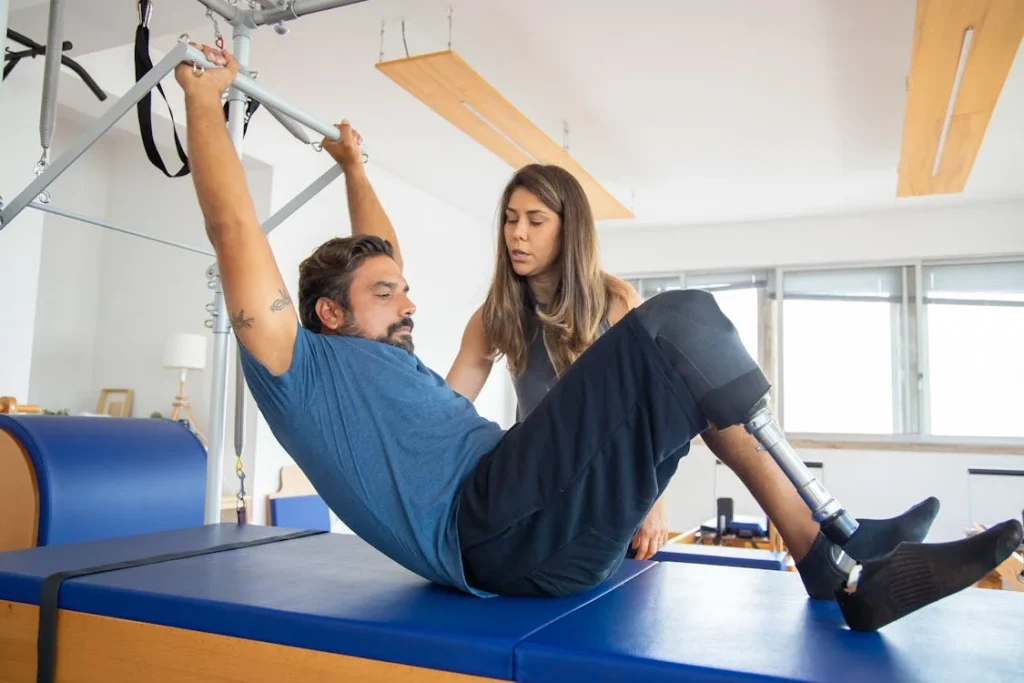Weightlifting and strength training are all about power, control, and precision. For individuals with limb loss, the right prosthetic can make a world of difference in their ability to train effectively and safely. Whether it’s lifting a barbell, executing a deadlift, or stabilizing a bench press, prosthetics designed for strength training provide the necessary grip, support, and stability to help athletes reach their full potential.

Understanding the Role of Prosthetics in Strength Training
Weightlifting is not just about raw power—it requires stability, grip control, and balanced force distribution. For individuals with limb loss, a prosthetic must function as a seamless extension of their body, providing the same strength and adaptability as a natural limb.
Whether lifting heavy weights or performing bodyweight exercises, the prosthetic must withstand intense pressure while allowing fluid movement.
Prosthetics designed for strength training focus on durability, grip security, and load distribution. For upper-limb amputees, the challenge lies in holding and controlling weights, while lower-limb amputees need strong, stable support to manage the heavy loads placed on their legs.
Custom-fit prosthetics tailored to weightlifting provide the best experience, ensuring maximum efficiency and comfort.
Upper-Limb Prosthetics for Weightlifting: Grip, Strength, and Stability
For individuals with upper-limb amputations, one of the biggest challenges in weightlifting is grip strength. The ability to hold and control barbells, dumbbells, and kettlebells is crucial for both performance and safety.
Traditional prosthetics, designed for everyday tasks, often lack the strength and adaptability required for heavy lifting. This is where specialized weightlifting prosthetics come into play.
One of the most effective prosthetic solutions for upper-limb amputees is the hook-style attachment, which offers a secure and locked grip on the bar.
Unlike traditional myoelectric hands, which rely on delicate motors and sensors, hook prosthetics provide a mechanical advantage by firmly clasping onto weights without risk of slipping.
These attachments allow lifters to pull, press, and curl without the limitations of an open-hand design.
For lifters who prefer a more natural hand function, myoelectric prosthetics with adaptive grip technology allow for dynamic control over weights.
These prosthetics use muscle signals from the residual limb to adjust grip strength in real-time, providing a balance between security and flexibility. While these require more training to master, they allow for a more intuitive lifting experience.
Lower-Limb Prosthetics for Strength Training: Stability, Shock Absorption, and Power
For athletes with lower-limb amputations, the primary focus in strength training is balance and load-bearing capacity. Whether performing squats, deadlifts, or lunges, the prosthetic leg must provide firm grounding and shock absorption to prevent injury and ensure proper form.
A key feature of weightlifting-specific lower-limb prosthetics is reinforced footplates, which distribute weight evenly across the surface to prevent tipping or instability.
Unlike traditional walking prosthetics, these are rigidly designed to maximize strength transfer between the ground and the athlete’s body.
Another crucial factor is adjustable resistance and shock absorption. Some advanced weightlifting prosthetics allow athletes to modify stiffness levels, enabling them to fine-tune their stance for different exercises.
A slightly more flexible setting might be preferred for movements requiring explosive power, like Olympic lifts, while a stiffer setting works best for heavy squats and deadlifts, where stability is key.
Prosthetic knee systems also play an essential role. For lifters who need additional support and control, hydraulic and pneumatic knee joints help absorb impact and maintain smooth movement, reducing strain on the residual limb.
These systems allow for controlled descent and stable ascent, making movements like squats and leg presses safer and more effective.
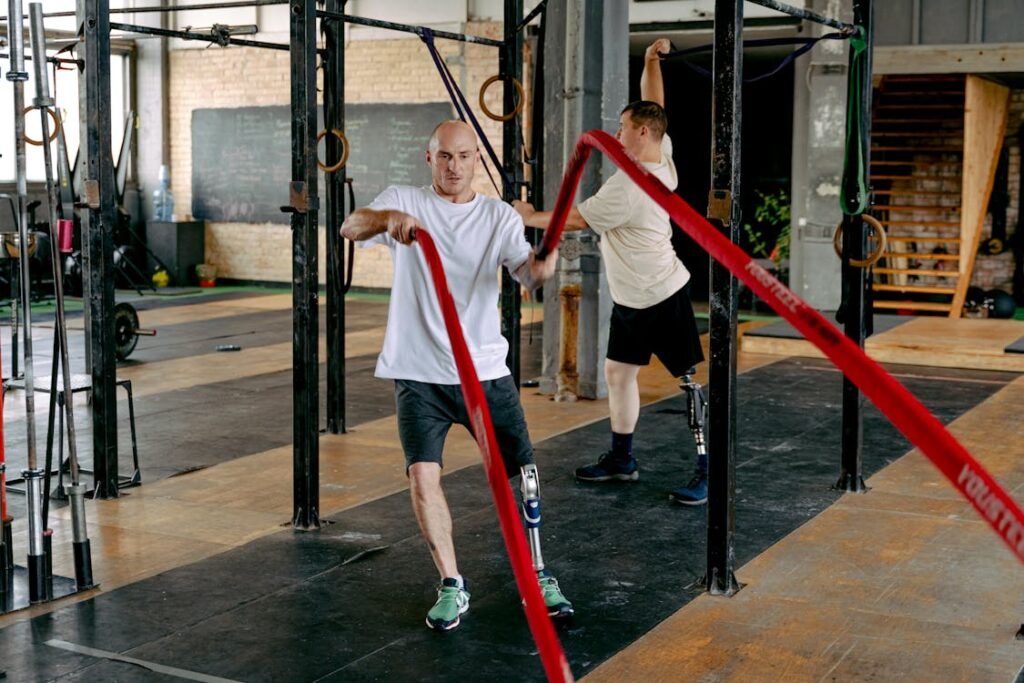
Adapting Weightlifting Techniques with Prosthetics
Lifting weights with a prosthetic limb requires technique adjustments and proper biomechanics to ensure efficiency, strength, and safety.
While the fundamentals of strength training remain the same, amputees must learn how to distribute force evenly across their body to compensate for the differences in movement and stability.
Mastering Grip Control and Strength for Upper-Limb Prosthetics
For upper-limb amputees, the primary challenge is securing a firm and stable grip on the barbell or dumbbell.
Unlike natural hands, which can make micro-adjustments to maintain control, prosthetic grips must be strategically positioned before each lift to prevent slipping or uneven pressure distribution.
When using a hook attachment, athletes must align the prosthetic perfectly with the barbell to avoid unnecessary strain on the wrist and elbow.
The key is to let the hook take the full load of the weight, rather than relying on residual limb strength to hold the bar. This technique is especially useful for exercises like deadlifts, rows, and farmer’s carries, where grip endurance plays a crucial role in overall performance.
For those using myoelectric prosthetic hands, mastering grip sensitivity is essential. Some prosthetic models allow users to adjust grip strength in real time, making it possible to switch between lighter and heavier weights during workouts.
However, myoelectric hands require greater muscle control and may take longer to adapt for heavier lifts.
Athletes training with prosthetics should focus on progressive overload, gradually increasing weight to build grip endurance and coordination.
Practicing with lighter weights and resistance bands before advancing to heavier loads ensures that the prosthetic is properly aligned and that movements remain smooth and controlled.
Maintaining Stability and Balance with Lower-Limb Prosthetics
For lower-limb amputees, stability is the foundation of strength training. Whether performing squats, lunges, or deadlifts, the prosthetic leg must provide a solid base to absorb force and prevent imbalance.
Unlike everyday walking prosthetics, which prioritize flexibility, weightlifting prosthetics need rigidity and a strong connection to the ground.
One of the most critical adjustments is stance positioning. Many lifters with a prosthetic leg find that a slightly wider stance provides better balance and even weight distribution.
This is particularly important for squats and deadlifts, where stability is crucial to maintaining good form and preventing strain on the intact limb.
For athletes using hydraulic or pneumatic knee prosthetics, learning to control descent and ascent movements is essential.
These systems help absorb impact when lowering into a squat or lunge, but improper technique can lead to excessive forward lean or instability.
Practicing slow, controlled movements before progressing to heavier weights allows lifters to develop confidence in their prosthetic’s responsiveness.
Another important consideration is foot positioning. Prosthetic footplates designed for weightlifting provide a stable, flat surface that enhances force transfer.
Unlike running or walking prosthetics, which often have a curved shape for propulsion, weightlifting prosthetics focus on ground contact and grip to prevent unwanted shifts during heavy lifts.
Adjusting Core Engagement and Posture
Regardless of whether an athlete uses an upper- or lower-limb prosthetic, core strength is essential for maintaining balance and control. A strong core helps distribute weight evenly, reducing compensatory movements that could lead to injury.
For athletes with an upper-limb prosthetic, core engagement prevents excessive leaning or twisting during pressing and pulling exercises.
Training anti-rotational core stability through exercises like planks, cable chops, and unilateral lifts helps ensure proper alignment and power transfer.
For lower-limb amputees, core strength plays a major role in offsetting any asymmetry in weight distribution. Engaging the abdominals, obliques, and lower back muscles ensures that movements stay controlled and prevents excess strain on the intact limb.
Exercises such as hanging leg raises, stability ball rollouts, and resisted side planks enhance posture and prevent imbalances that could lead to injury.
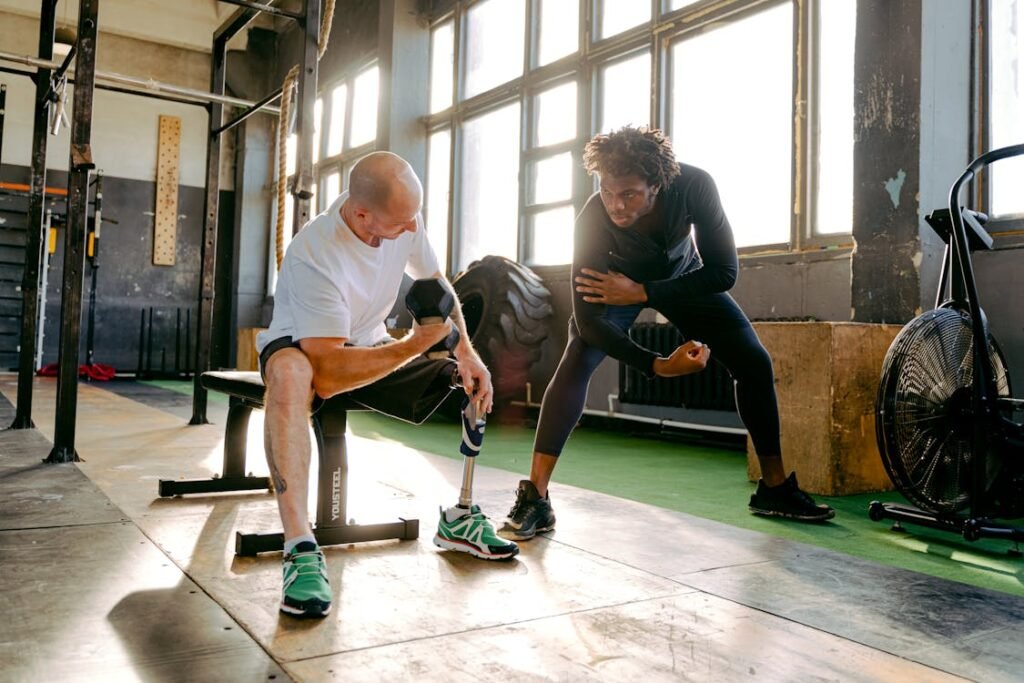
Preventing Injuries and Maximizing Performance with Prosthetics
Training with a prosthetic limb requires a strategic approach to prevent injuries while ensuring optimal performance. Since prosthetics function differently than natural limbs, athletes must be mindful of load distribution, joint strain, and muscular imbalances.
By implementing proper warm-ups, recovery strategies, and progressive training methods, lifters can minimize risks and enhance their strength potential.
Proper Warm-Up and Mobility Work for Prosthetic Athletes
Warming up before strength training is essential for all athletes, but it is particularly important for those using prosthetics. Since a prosthetic limb does not have the same sensory feedback and flexibility as a natural limb, it’s crucial to prime the muscles and joints for movement.
For upper-limb amputees, warming up the shoulders, elbows, and core helps maintain control and stability during pressing and pulling exercises. Simple shoulder circles, resistance band rows, and wrist mobility drills can prepare the body for the demands of weightlifting.
For lower-limb amputees, hip and knee mobility drills ensure that the prosthetic limb moves smoothly throughout exercises. Bodyweight squats, hip openers, and ankle mobility drills help activate stabilizing muscles and reduce stiffness before lifting heavy loads.
Managing Load Progression and Fatigue
Unlike natural limbs, prosthetics do not have muscle fatigue or recovery signals, meaning athletes must be careful not to overload too quickly. Strength training should follow a progressive overload approach, where weights are gradually increased while maintaining proper form.
For upper-limb prosthetic users, grip fatigue can set in faster, especially when using hook attachments or myoelectric hands. Incorporating rest intervals and grip endurance exercises helps sustain performance throughout the workout.
For lower-limb prosthetic users, excessive fatigue in the intact leg can lead to compensatory movements that increase injury risk.
Strengthening both sides of the body evenly through unilateral exercises like step-ups, Bulgarian split squats, and single-leg Romanian deadlifts helps maintain muscular balance.
Recovery Strategies for Long-Term Performance
Recovery plays a crucial role in preventing overuse injuries and ensuring consistency in training. Since prosthetics alter movement patterns, certain muscles may experience more strain than others, leading to tightness or discomfort if not properly addressed.
For upper-limb athletes, using compression therapy and active stretching for the shoulders and arms can reduce muscle soreness and improve mobility. Foam rolling the upper back and forearms helps relieve tension from gripping exercises.
For lower-limb athletes, soft tissue work on the hips, quads, and hamstrings prevents stiffness and enhances range of motion. Hydration, proper nutrition, and rest days also contribute to muscle recovery and sustained strength gains.
Psychological Resilience in Strength Training with Prosthetics
Beyond the physical aspect, mental toughness is crucial for athletes training with prosthetics. Strength training is a journey that requires patience, consistency, and a willingness to adapt.
Many lifters experience frustration when adjusting to a new prosthetic or refining their technique.
Setting realistic, progressive goals keeps motivation high. Tracking small victories, such as increasing grip strength, improving balance, or lifting heavier weights, helps reinforce progress.
At Robobionics, we believe that weightlifting with a prosthetic is not just about adapting—it’s about thriving.
By using the right prosthetic solutions, applying proper training techniques, and maintaining a strong mindset, athletes can achieve incredible strength and performance.

Customizing Prosthetic Solutions for Strength Training Success
No two athletes are the same, and the best prosthetic for weightlifting is one that is customized to fit an individual’s training style, body mechanics, and performance goals.
From specialized grip attachments to reinforced lower-limb designs, tailored prosthetic solutions can make a significant difference in strength training outcomes.
Choosing the Right Grip for Upper-Limb Weightlifters
Grip control is a crucial factor for upper-limb amputees engaged in strength training. Depending on the exercises performed, different prosthetic grips provide unique advantages.
For heavy deadlifts, barbell rows, and pull-ups, a locking hook attachment is often the best choice. These hooks offer a secure, fixed grip on the bar, eliminating the risk of losing control during high-load movements.
The ability to maintain a consistent grip without exhausting the residual limb allows athletes to focus on muscle engagement rather than hand fatigue.
For exercises requiring greater dexterity, such as kettlebell swings or dumbbell presses, a specialized multi-grip prosthetic hand provides more versatility.
These adaptive hands use adjustable tension settings, enabling lifters to grip weights with more precision. Some even feature quick-release mechanisms that allow for fast transitions between exercises.
Myoelectric prosthetic hands, while advanced, require careful muscle signal control to maintain a steady grip.
For bodybuilders or powerlifters who train with variable resistance, choosing a prosthetic with customizable grip strength settings ensures that the hand can handle different weights efficiently.
Fine-Tuning Lower-Limb Prosthetics for Maximum Power
For lower-limb amputees, a properly designed prosthetic foot, ankle, and knee system plays a crucial role in maximizing strength. The wrong prosthetic setup can lead to imbalanced force distribution, increasing the risk of injury or underperformance.
Athletes performing heavy squats or leg presses benefit from flat-bottom footplates, which provide a stable base for weight transfer.
Unlike standard prosthetic feet, which often have a curved toe section for walking, flat-foot designs enhance balance and force absorption, ensuring even weight distribution during lifts.
For those engaging in explosive movements, such as Olympic lifting, a prosthetic foot with moderate flexibility allows for better force redirection while still maintaining structural integrity.
Adjustable ankle and knee joints help lifters fine-tune their stance based on the demands of their sport.
Some lower-limb athletes also use specialized knee sleeves or external supports to provide additional reinforcement during max-effort lifts. These supports reduce pressure on the residual limb, allowing lifters to handle heavier loads with greater confidence.
How 3D-Printed Prosthetics Are Changing Strength Training
One of the most exciting advancements in adaptive strength training is the rise of 3D-printed prosthetics, which allow for fully customized designs based on an athlete’s specific needs.
Unlike mass-produced prosthetic components, 3D printing enables lightweight, high-strength materials to be molded into personalized shapes and sizes, ensuring a perfect anatomical fit.
For weightlifters, this means:
- More precise weight distribution for lower-limb prosthetics, reducing imbalance during squats and deadlifts.
- Custom-fitted grip attachments that match the athlete’s hand proportions for a more natural hold on bars and dumbbells.
- Stronger, impact-resistant materials that withstand the repeated stress of high-intensity lifting.
At Robobionics, we embrace next-generation prosthetic solutions that cater to the evolving needs of strength athletes.
Whether through custom molding, advanced materials, or smart prosthetic integration, we ensure that every adaptive lifter has the best possible tools to excel in the gym.
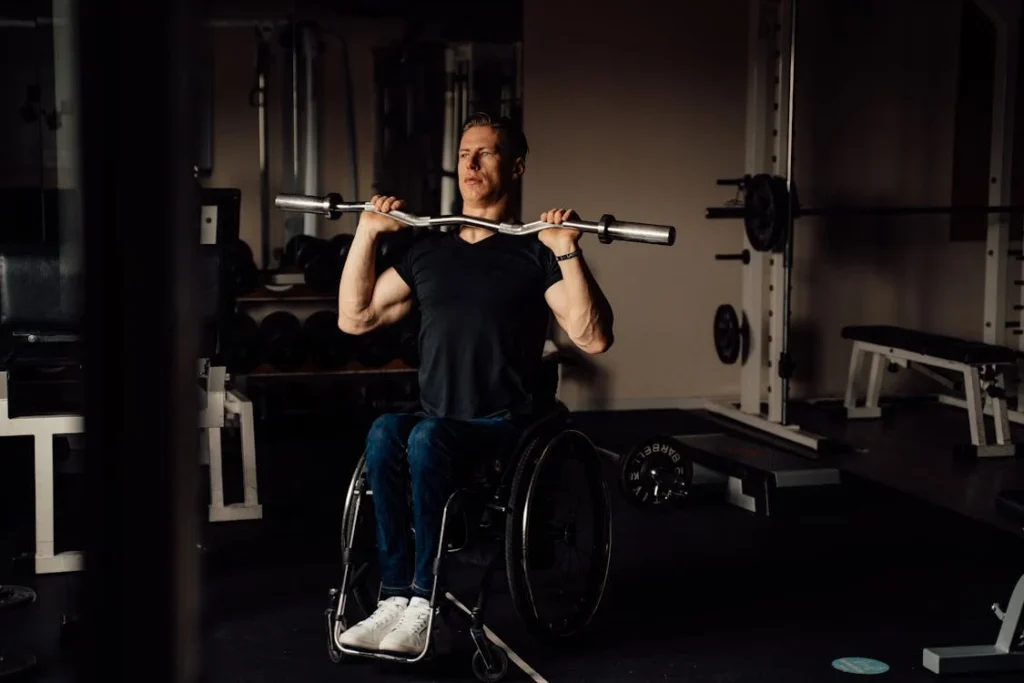
The Role of Adaptive Training Techniques for Prosthetic Athletes
Using a prosthetic in strength training is not just about having the right equipment—it’s about learning how to move efficiently, distribute force correctly, and adapt training techniques to maximize performance.
Adaptive athletes must fine-tune their approach to ensure that their prosthetic enhances their strength rather than limiting their potential.
Adjusting Training Splits for Balanced Development
For prosthetic users, maintaining muscle symmetry and joint stability is a key factor in preventing overuse injuries.
Training splits—how workouts are structured throughout the week—should be adjusted to account for any imbalances in movement patterns or muscle activation.
For upper-limb amputees, a traditional push-pull split might need modifications. Since a prosthetic may not engage all stabilizing muscles the same way a natural limb would, additional core and unilateral exercises help maintain balance.
Training the opposite side with controlled, isolated movements also prevents compensation that could lead to strain.
For lower-limb amputees, leg training often requires a more focused approach to single-leg stability and force absorption. Incorporating step-ups, Bulgarian split squats, and sled pushes ensures both legs develop evenly, reducing excess strain on the intact limb.
Athletes who use myoelectric upper-limb prosthetics may also need to rotate their workouts to prevent excessive battery drain, ensuring their device remains responsive throughout training sessions.
Modifying Exercise Form for Safety and Efficiency
Lifting with a prosthetic requires some adjustments to traditional form to account for differences in movement mechanics. These modifications are not about reducing difficulty but about ensuring maximum control and efficiency.
For bench presses and shoulder presses, upper-limb prosthetic users may need to adjust wrist positioning to keep the prosthetic aligned with the natural pressing path. A slightly wider grip can also help distribute force more evenly, preventing strain on the residual limb.
For deadlifts and bent-over rows, athletes using a prosthetic arm should focus on keeping the spine neutral and engaging the core to avoid compensating with the intact side. If using a hook attachment, ensuring that it is properly secured to the bar prevents any mid-lift instability.
For squats and lunges, lower-limb amputees should be aware of hip alignment and weight distribution. A slight external foot rotation may help maintain balance, while controlled tempo squats improve overall movement efficiency and prosthetic responsiveness.
Incorporating Unilateral and Functional Training
To enhance overall stability and muscle coordination, prosthetic athletes benefit from unilateral training, where one side of the body is worked independently. This prevents over-reliance on the intact limb and ensures that both sides contribute equally to strength development.
For upper-limb amputees, incorporating single-arm presses, single-arm rows, and kettlebell carries strengthens stabilizing muscles and improves prosthetic control.
For lower-limb amputees, step-ups, single-leg Romanian deadlifts, and sled drags reinforce balance and ensure that the prosthetic leg is actively engaged rather than passively supporting movements.
Functional movements, such as farmer’s carries, medicine ball throws, and resistance band drills, also help build core control and full-body coordination, making everyday movement and lifting more fluid and powerful.
At Robobionics, we emphasize adaptive training strategies that help prosthetic athletes train smarter, lift heavier, and move more efficiently.
By combining the right equipment, biomechanics, and customized training techniques, lifters can maximize their potential while reducing the risk of injury.
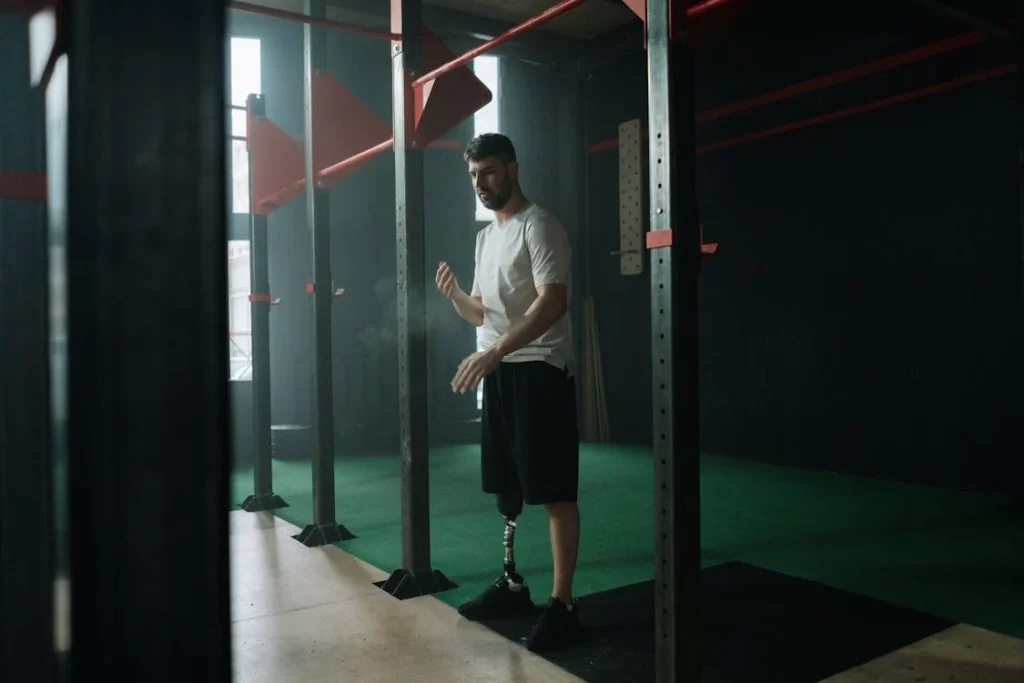
The Psychological Strength Behind Adaptive Weightlifting
Strength training with a prosthetic is not just about physical power—it’s a mental challenge that requires discipline, resilience, and a strong mindset.
Many adaptive athletes face unique psychological hurdles, from overcoming initial self-doubt to dealing with the pressure of competing in able-bodied or adaptive lifting events. However, the ability to push past these challenges builds not just strength, but unshakable confidence.
Overcoming Mental Barriers in Strength Training
One of the biggest psychological challenges for prosthetic users in weightlifting is the fear of limitations.
Many athletes, especially those new to training with a prosthetic, worry that they won’t be able to lift as effectively as their able-bodied peers. This mindset can create hesitation and self-imposed restrictions.
The key to breaking through these mental barriers is focusing on ability, not disability. Adaptive lifters who shift their mindset from “Can I do this?” to “How can I do this?” find creative solutions to their challenges.
Strength training is all about problem-solving—modifying techniques, experimenting with prosthetic attachments, and refining movement mechanics to achieve the same results in a different way.
Visualization techniques can also help athletes build confidence before attempting new lifts. By mentally rehearsing their form, grip, and movement patterns before stepping up to the bar, lifters develop a stronger connection between mind and body, making execution feel more natural.
Staying Motivated and Tracking Progress
Progress in weightlifting is measured in small, steady gains. For prosthetic athletes, tracking improvements—whether it’s lifting heavier, refining technique, or increasing endurance—helps maintain motivation and provides tangible proof of growth.
Many adaptive lifters find that keeping a training journal or using a fitness tracking app helps them stay consistent. Recording each workout, noting improvements in grip control, balance, or strength endurance, provides a clear picture of progress over time.
Setting personal goals also keeps motivation high. Whether it’s hitting a new bench press PR, mastering deadlift form, or competing in an adaptive powerlifting event, having specific goals fuels drive and determination.
Building a Supportive Training Environment
Surrounding yourself with positive, knowledgeable coaches and training partners can make a massive difference in confidence and performance.
Many adaptive athletes benefit from working with trainers who specialize in prosthetic-assisted lifting, as they can offer expert guidance on modifications and injury prevention.
Being part of an inclusive lifting community—whether at a gym, online, or in adaptive sports organizations—provides encouragement and inspiration.
Seeing other prosthetic athletes lifting heavy, pushing limits, and excelling in strength training proves that anything is possible with the right mindset and approach.
At Robobionics, we believe that the mind is just as powerful as the body in strength training.
By embracing mental resilience, tracking progress, and building a strong support system, prosthetic athletes can unlock their full lifting potential and redefine what strength truly means.
Conclusion
Weightlifting and strength training with a prosthetic are not just about adapting—they’re about thriving. With the right prosthetic solutions, training techniques, and mindset, athletes can push their limits, lift heavier, and train smarter. Whether it’s mastering grip control, improving balance, or refining technique, customized prosthetics empower lifters to perform at their highest level.
The journey isn’t just physical—it’s mental. Overcoming self-doubt, staying consistent, and tracking progress are key to long-term success. Strength is measured not just in weights lifted, but in determination, resilience, and persistence. Adaptive athletes continue to prove that limb loss is not a limitation, but an opportunity to innovate and achieve greatness.
At Robobionics, we are committed to providing high-performance prosthetic solutions tailored for strength training. Whether you’re new to weightlifting or aiming for elite performance, we’re here to help you train without limits.
Ready to take your training to the next level? Contact Robobionics today to explore prosthetic options designed for power, precision, and performance. Your journey to unbreakable strength starts now.



